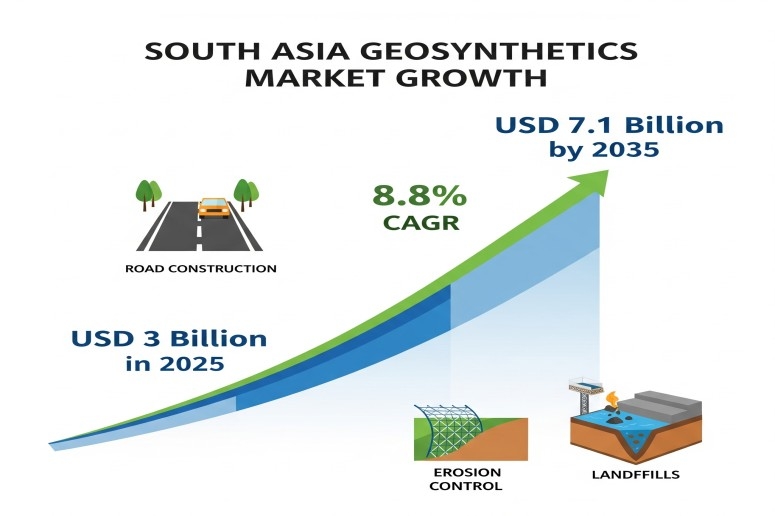Geosynthetics Industry Analysis in South Asia Research Report 2025 to Global Forecast till 2035

The South Asia geosynthetics market is set for remarkable growth, increasing from USD 3 billion in 2025 to USD 7.1 billion by 2035, advancing at an impressive 8.8% CAGR over the forecast period. This expansion is driven by surging infrastructure investments, rapid urbanization, and growing environmental concerns, making geosynthetics a key enabler in the region’s sustainable development agenda.
This rapid expansion is driven by large-scale infrastructure projects, urbanization demands, and an increasing focus on sustainability. As nations like India, Bangladesh, and Sri Lanka channel investments into modernizing their transportation, water management, and environmental protection systems, geosynthetics are becoming indispensable to engineering and construction strategies.
Unlock Growth Potential – Request Your Sample Now and Explore Market Opportunities!
https://www.futuremarketinsights.com/reports/sample/rep-as-3849
Geosynthetics refer to synthetic materials used in civil engineering and environmental applications to reinforce, separate, filter, drain, or protect soil and related structures. Typically made from polymeric materials such as polypropylene, polyester, and polyethylene, these products offer enhanced durability and performance in challenging conditions.
Strategic Role of Geosynthetics in South Asia’s Infrastructure Development
The region’s governments and private sector stakeholders are recognizing the long-term value of geosynthetics in enhancing infrastructure quality. Mega infrastructure projects in India, Bangladesh, Pakistan, Sri Lanka, and Nepal are integrating geosynthetics into their designs to improve performance, reduce maintenance costs, and extend project lifespans.
From highway embankments and railway ballast stabilization to airport runways and coastal barriers, geosynthetics are now standard engineering solutions. Their ability to enhance soil strength, control erosion, and provide efficient drainage has made them indispensable in meeting the region’s infrastructure ambitions.
Key Takeaways from the Geosynthetics Industry Analysis in South Asia
- The geocomposites segment is forecasted to register the highest CAGR of 7.8% from 2025 to 2035.
- The barrier & protection segment is anticipated to expand at a rapid CAGR of 7.4% during 2025–2035.
- The environmental protection segment is expected to achieve a strong CAGR of 7.6% in the same period.
- The polypropylene segment is projected to grow at a notable CAGR of 7.2% between 2025 and 2035.
- India is projected to lead regional growth with a CAGR of 9.4% from 2025 to 2035.
- Indonesia is forecasted to follow closely with a CAGR of 9.2% over the forecast period.
- The Philippines is expected to grow at a robust CAGR of 8.6% from 2025 to 2035.
- Malaysia is anticipated to post a CAGR of 8.4% during the same timeframe.
- Australia is projected to expand steadily with a CAGR of 8.2% from 2025 to 2035.
Growth Drivers in the Geosynthetics Industry Analysis in South Asia
The following factors will propel the geosynthetics industry forward in South Asia:
- Infrastructure Expansion
The region is experiencing a construction boom. The need for highways, high-speed rail corridors, and upgraded airport facilities is surging, with geosynthetics playing a pivotal role in ensuring durability and stability. - Coastal and Flood Protection
Climate change-induced sea-level rise and extreme weather events have increased demand for erosion control and shoreline protection solutions, where geotextiles and geomembranes excel. - Sustainability Mandates
Governments are implementing green building codes and environmental regulations that favor eco-friendly construction materials like geosynthetics. - Urbanization Trends
By 2030, urban populations in South Asia are expected to expand significantly, necessitating advanced drainage, waste management, and transportation systems—sectors that benefit from geosynthetic integration. - Cost Efficiency
With construction budgets under pressure, contractors are opting for geosynthetics to cut costs without compromising on quality and performance.
Competitive Landscape
The South Asia geosynthetics market features a mix of global giants and regional manufacturers. Leading international companies are leveraging joint ventures, local partnerships, and technology transfers to capture market share. Simultaneously, domestic players are investing in R&D to meet region-specific challenges such as high humidity, saline environments, and variable soil conditions.
Key Market Players
- TechFab India Industries Ltd.
- Garware Technical Fibres Ltd.
- Terram Geosynthetics Pvt. Ltd.
- Skaps Industries
- Strata Geosystems (India) Pvt. Ltd.
- Polyfabrics
- Maccaferri Environmental Solutions Pvt. Ltd.
- Maharshee Geomembrane
- Megaplast India Pvt. Ltd.
- Siddhi Vinayak Engineering & Fabricators
- GEO & ENVIRONMENTAL SERVICES
- ACE Geosynthetics
- Techno Fabrics Geosynthetics Pvt. Ltd.
Key Segments Analysis of South Asia Geosynthetics Industry
By Product Type:
Geogrids, Geotextiles, Geocells, Geonets, Geocomposites, Geomembranes, Geosynthetic clay liners, Others
By Application:
Road Construction, Civil Engineering, Environmental Protection, Hydraulic, Construction, Others
By Material Type:
Polypropylene, Polyethylene, Polyester, Polyvinyl Chloride, Natural Fibers, Others
By Primary Function:
Stabilisation, Reinforcement, Drainage, Erosion control, Filtration, Separation, Barrier & Protection
By Country:
India, Indonesia, Malaysia, Thailand, Vietnam, Philippines, Australia, New Zealand, Rest of South Asia
Checkout Now to Access Data Insights:
https://www.futuremarketinsights.com/checkout/3849
About Future Market Insights (FMI)
Future Market Insights, Inc. (ESOMAR certified, recipient of the Stevie Award, and a member of the Greater New York Chamber of Commerce) offers profound insights into the driving factors that are boosting demand in the market. FMI stands as the leading global provider of market intelligence, advisory services, consulting, and events for the Packaging, Food and Beverage, Consumer Technology, Healthcare, Industrial, and Chemicals markets. With a vast team of over 400 analysts worldwide, FMI provides global, regional, and local expertise on diverse domains and industry trends across more than 110 countries.
- Questions and Answers
- Opinion
- Motivational and Inspiring Story
- Technology
- Live and Let live
- Focus
- Geopolitics
- Military-Arms/Equipment
- Sicherheit
- Economy
- Beasts of Nations
- Machine Tools-The “Mother Industry”
- Art
- Causes
- Crafts
- Dance
- Drinks
- Film/Movie
- Fitness
- Food
- Spiele
- Gardening
- Health
- Startseite
- Literature
- Music
- Networking
- Andere
- Party
- Religion
- Shopping
- Sports
- Theater
- Health and Wellness
- News
- Culture

